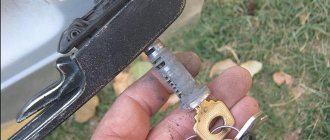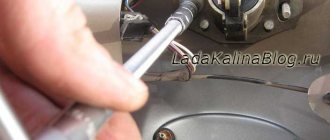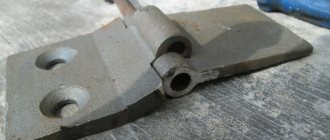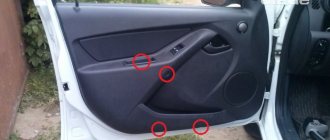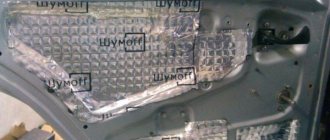Physics is not in your favor
The above problems occur due to the fact that in the cold, water turns into ice and “fetters” the lock mechanisms. It gets there either during washing, after which it is important to thoroughly blow out the openings and locks, or it accumulates on its own during operation - and at the most inopportune moment it turns out to be enough to cause problems for the motorist. The same applies to freezing door seals: you can either not get into the car or use excessive force and break the rubber bands. What to do to avoid these troubles?
They have already said about washing: it is necessary to blow through both the openings and the locks - their cylinders and the actual locking mechanisms located at the ends of the doors. Door seals and interior parts should be wiped dry and should not be left wet. If the situation is frosty, we recommend slamming the doors thoroughly half an hour to an hour after washing - this way you will “shake off” the ice that has just appeared and is not yet very strong.
Features of caring for a padlock
The main purpose of caring for such a lock is to remove dirt and dust from it. As well as ensuring good operation of the locking mechanism. Therefore, to ensure the conditions for good operation of the padlock, simple operations should be performed consistently. The algorithm of actions is given below.
How often does the lock need to be serviced? If the padlock is located indoors and is not exposed to precipitation or changes in humidity, then you can clean it once a year. If the lock is located outdoors, the frequency of cleaning and lubrication must be increased to 45 times a year. The core must be serviced before the onset of cold weather.
Cleaning from dirt and dust
Dust and dirt accumulate in the padlock unnoticed. Even if the keyhole is located at the bottom, dirt penetrates into the lock. And they gradually accumulate. As a result, the mechanism deteriorates and the lock fails.
To thoroughly clean the inside of the lock, you will need to remove foreign particles from its internal mechanism. And to get the best results, it is recommended to use professional cleaning products. They are introduced in large quantities into the core of the lock. Next, the key is inserted inside to its full depth. And then the key comes out. And the accumulated garbage will come out with it. There is no need to turn the key in the lock. The operation must be repeated until a completely clean key in light grease comes out of the lock.
Lubricate the mechanism
Many people use regular machine oil to lubricate a padlock. However, in cold weather such oil becomes viscous and complicates the process of opening the lock. Therefore, it is recommended to use professional products for lubrication. Many modern lock manufacturers also offer maintenance products.
However, you can also use inexpensive methods to ensure reliable operation of locks. They are easy to make yourself and always have on hand.
The following simple padlock lubricant recipe will help you perform preventative maintenance:
- take a simple pencil or graphite from it;
- Thin plates of the substance are carefully cut from the resulting rod. A blade or sharpened knife is used;
- the result is fine graphite dust, which needs to be placed on a sheet of paper;
- When you get a couple of small portions of dust, you should roll the paper into a tube. Bring the tube to the keyhole and blow it in.
Our lock is lubricated and will work even under particularly difficult external conditions!
This simple procedure should be repeated after each cleaning at least once a year. And then the padlock will serve for a long time without causing any difficulties during its operation.
The best remedy is prevention
The risk of problems can be significantly reduced by pre-treating the parts with suitable products. And here the choice will depend on the node. So, it is better to pour a little universal lubricant into the lock cylinders - mineral oil without additives. If there is no such thing on the farm, regular motor oil will do.
But it is better to treat door hinges and locking mechanisms with a special adhesive lubricant. The fact is that these parts have friction between each other; ordinary oil does not stay on them for a long time. Therefore, it is preferable to use special products that “stick” to materials and cannot simply be removed. In this case, it is better to use lubricants with Teflon additives, which will also prevent the adhesion of dust (these are used, for example, for motorcycle chains). An important point: these products are not suitable for treating larvae, because they can simply cause the secret parts of the mechanism to stick.
You may say: why such difficulties? Isn’t it easier to use a universal product like WD40? No! Even though the “Vedeshka” has cleansing properties and displaces moisture, it cannot be considered as a protective agent, it is too “dry” and additional lubrication is needed.
Prevention
In order to be sure in winter that something similar will not happen to you, it is recommended to carry out preventive measures even before the onset of cold weather. What do primitive preventative measures for freezing car locks include?
- First of all, pay attention to the seals. Carefully inspect them for dirt, debris and cracks, since often this oversight can lead to depressurization and allow moisture to get inside, which, in turn, can easily cause not only the locks, but also the doors of your car to freeze.
- Protect the seals with lubricant. All-purpose silicone grease works well. It has a good water-repellent effect and will also extend the life of your seals.
- An effective option is a warm garage or parking lot. So, you will save yourself not only from frozen locks, but also from many problems that plague car enthusiasts during the cold season.
Silicone is power! Sometimes excessive...
To prevent freezing of rubber and plastic parts (doors, windows, door handles), it is recommended to lubricate them with silicone lubricants. Which is what many motorists do, sometimes with great zeal. Meanwhile, it should be borne in mind that silicone has strong anti-adhesive properties, so getting it on the paintwork of the body is very undesirable. In the case of painting repairs, this may result in the appearance of craters where silicone molecules remain (not every solvent accepts it).
Second point: if silicone gets on the glass, an oily film will form. And if the windshield wiper blades start to smear it... In general, despite the fact that silicone lubricants are sold in spray cans, it is better not to spray them, but to apply them to a sponge and use it to treat the plastic and rubber parts that require it.
Reasons for jamming locks
The most common cause of a stuck locking mechanism is dust. Over time, the dust is compressed together with small particles of metal shavings and blocks the rotation of the key and bolts.
The second reason for jamming is abrasion of the mechanism parts. This is the result of lack of care or poor quality of care. During operation, the parts gradually grind against each other, causing the formation of metal chips, which over time leads to complete wear of the parts.
The next reason is the formation of rust inside the mechanism. This is mainly a problem with external locks, which become unusable under the influence of weather conditions. If you prevent moisture from getting on the mechanism itself, you can avoid breakdowns and jamming during operation.
And another common reason is a violation of the sliding of the moving parts of the mechanism. This is a consequence of the lack of lubrication, so regular lubrication of the mechanism and its cleaning will significantly extend the life of the device without complaints from the owner of the house or garage.
Not just doors
One more note. During preventive measures, remember not only about the side doors - do not forget about the hood, trunk and gas tank flaps. And also about the neck plug, if it has a key. It’s not very pleasant to find yourself in a situation where you’re already close to the pump, but you can’t reach the plug. However, this is not the worst scenario, since at a gas station you can always find the opportunity to defrost the lock. But if you have an old Ford, where the hood can be opened with a key, there is a possibility of finding yourself in a stupid situation. Moreover, the lock behind the front emblem often freezes or even turns sour.
How to defrost?
Let's say you decide to do without prevention or it was not enough to protect the locks from freezing. What should I do? At one time, we tried a variety of methods for defrosting lock cylinders, starting with the use of special means and ending with old-fashioned methods. Their effectiveness and further consequences (what happened to the lock after some time) are clearly demonstrated by this table:
| Defrosting method | Time spent | In 30 minutes | In 60 minutes |
| Breathing | 6 minutes 37 seconds | the key cannot be inserted | |
| Exhaust gases | 5 minutes 12 seconds | the key cannot be inserted | |
| Heat the key with fire | 4 minutes 7 seconds | the key won't turn | |
| Hot water | 2 minutes 7 seconds | the key won't turn | |
| Vodka | the key cannot be inserted | ||
| Hawthorn tincture | 6 minutes 15 seconds | the key is inserted and turned | |
| Brake fluid | 4 minutes 57 seconds | the key is inserted and turned | |
| Ice defroster 1 | 5 minutes 10 seconds | The key is difficult to insert and turn | |
| Ice defroster 2 | 7 minutes 15 seconds | Everything is fine | with difficulties |
| WD40 | 15 minutes 35 seconds | with difficulties | the key won't turn |
As we can see, only after using defrosters (and also hawthorn tincture containing more than 60% alcohol) did the locks retain their functionality some time after defrosting. Traditional methods allow you to open the door (hatch), but then, in order to avoid repeated “sticking” of the mechanism, it must be treated with a moisture-displacing agent and lubricated.
What to do if it is the locking mechanism that freezes? Sometimes this happens when the door is open and the lock does not engage. This is not the worst option, because you have access to the mechanism itself, it can be treated with one or another means. Or warm up the interior thoroughly - and after some time the lock will work. True, once the author of these lines had to warm up while driving, and in order for the door to remain in the closed position, he had to fasten it to the center pillar with a seat belt...
It’s worse if the lock is frozen in the closed position and the door (trunk lid) cannot be opened, and there is no alternative access. Here you will have to warm the castle from the outside. The options may be different: use a heating pad or simply a plastic bottle filled with hot water, supply exhaust gases through a pipe, or in critical circumstances, pour hot water on the door, which is harmful to the paintwork. In any case, the effectiveness of these methods is not very high. To increase your chances, you need to heat exactly the area of the body where the locking mechanism is located.
Our verdict
Of course, there are no hopeless situations: if you can’t open the car yourself or it’s not possible to use one of the methods indicated above, you can always call specialists or, if nothing and no one helps, even load the car onto a tow truck and take it to a warm box. But we repeat: the best solution to the problem is prevention. Simply treat the locks with a suitable product and you will significantly reduce the risk of problems. And don't forget to take extra drying measures after washing. Smooth roads!
Close everything! Central locks in the Automotive Business ad database


